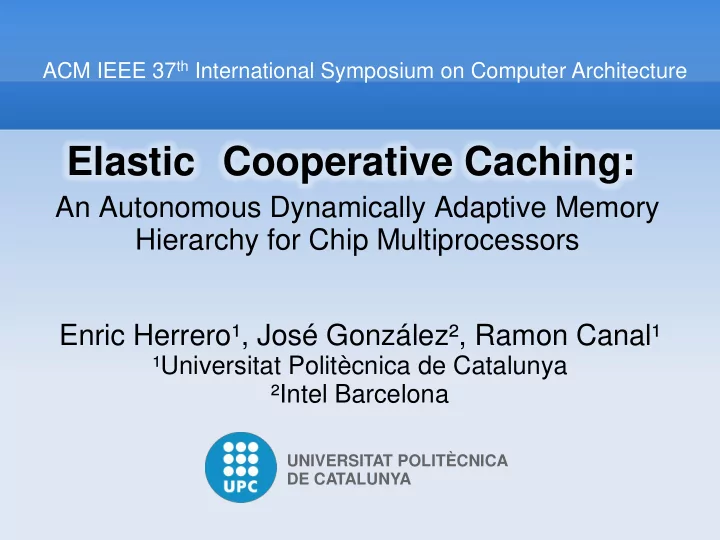

ACM IEEE 37 th International Symposium on Computer Architecture Elastic Cooperative Caching: An Autonomous Dynamically Adaptive Memory Hierarchy for Chip Multiprocessors Enric Herrero¹, José González², Ramon Canal¹ ¹Universitat Politècnica de Catalunya ²Intel Barcelona UNIVERSITAT POLITÈCNICA DE CATALUNYA
Outline Motivation Related Work Elastic Cooperative Caching Evaluation Conclusions
Motivation Find optimal cache organization for tiled microarchitectures Avoid centralized structures. Desired behavior Data placement based Scalable on proximity. Minimize access latency Minimize inter-thread Private cache partitions. interference Dynamic cache Minimize off-chip misses allocation.
Motivation Application Taxonomy Saturating Utility Low Utility Shared High Utility Private High Utility Extended classification from Qureshi et al. [MICRO'06]
Related Work Reactive NUCA [ISCA'09] Adaptive Selective Replication [MICRO'06] Adaptive Shared/Private NUCA [HPCA'07] OS-page granularity. More: Athena Software based. Award Lecture Mary Jane Irwin Common shared cache space. Adjusts replication but not amount of cache per node. Centralized structures.
Elastic Cooperative Caching – Structure Herrero et al. [PACT’08] Allocates evicted blocks Only local core from all private can allocate regions Every N cycles repartitions cache based on Distributes LRU hits in S&P evicted blocks partitions. from private partition among nodes.
Elastic Cooperative Caching – Adaptive Spilling ElasticCC oportunity: Not only repartition but also decide which nodes can use shared partitions. Type Working Sharing Local Private Spilling Set Size Reuse Cache Size Saturating Small/ H/L H/L Small/ No Utility Medium Medium Low Utility Big Low Low Small No Shared Big High H/L Small Yes High Utility Big Yes Private Big Low High High Utility Spill shared blocks or blocks fromcaches with 75% or more private cache space
Elastic Cooperative Caching – Structure Desired behavior Distributed cache among nodes. Scalable Local allocation. Minimize access latency Minimize inter- thread interference Private Regions. Minimize off-chip misses Cache Partitioning. Dynamic Cache Independent local Allocation. repartitioning units.
Evaluation – Studied Configurations 16 Processors Pairs of SPEC OMP’01 benchmarks of each of previous categories. Configurations Shared Memory Private Memory Distributed Cooperative Caching (DCC) Adaptive Selective Replication (ASR) Elastic Cooperative Caching ElasticCC + Adaptive Spilling Ideal : Fixed Half Private/Half Shared 2xL2
Evaluation – Performance & Efficiency +24% +12% Over Over ASR ASR
Evaluation – Off-Chip Misses & Reuse 19% 16% Over Over DCC ASR
Evaluation – Cache Behavior Evaluation – Cache Behavior Gafort – Low Utility Apsi, Art, Equake – Saturating Utility Ammp – Shared High Utility Swim – Private High Utility
Evaluation – Cache Behavior Evaluation – Cache Behavior Gafort – Low Utility No reuse, does not benefit from caches.
Evaluation – Cache Behavior Evaluation – Cache Behavior Apsi, Art, Equake – Saturating Utility Benefits from a given ammount of extra cache
Evaluation – Cache Behavior Evaluation – Cache Behavior Ammp – Shared High Utility Benefits from shared cache space.
Evaluation – Cache Behavior Evaluation – Cache Behavior Swim – Private High Utility Always benefits from extra cache
Evaluation - Temporal Cache Behavior Gafort-Equake execution, Equake Thread 1
Conclusions Elastic Cooperative Caching Distributed organization Adaptive behavior to application requirements Performance Energy-Efficiency Off-Chip Misses -19% +27% +71% Over Over Over DCC -16% DCC DCC +12% +24% Over Over Over ASR ASR ASR
ACM IEEE 37 th International Symposium on Computer Architecture Elastic Cooperative Caching: An Autonomous Dynamically Adaptive Memory Hierarchy for Chip Multiprocessors Enric Herrero¹, José González², Ramon Canal¹ ¹Universitat Politècnica de Catalunya ²Intel Barcelona eherrero@ac.upc.edu UNIVERSITAT POLITÈCNICA DE CATALUNYA
Recommend
More recommend